How long is tuna salad good for? (Fridge Shelf Life)
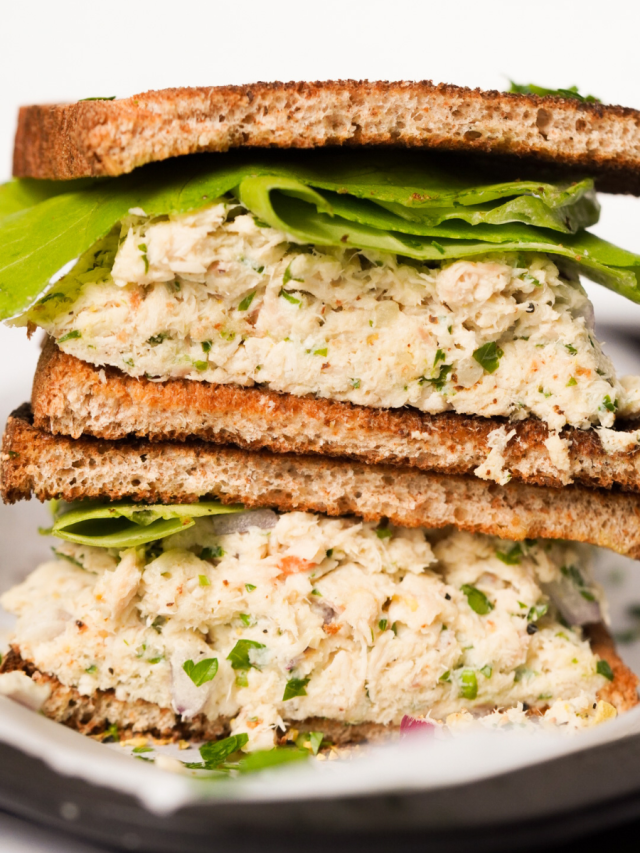
How long is tuna salad good for? Answer:
While I have lots of information for you regarding tuna salad in this post, including proper storage methods and ways to prolong it’s shelf life, let’s cut to the chase and answer the question everyone is here for: How long is tuna salad good for?
According to FoodSafety.gov, tuna salad is good for 3-4 days when properly stored in the refrigerator. This goes for all cold salads too – egg salad, chicken salad, macaroni salad, etc. This storage time aligns with USDA guidelines which state that refrigerated “cooked meat, poultry, and fish leftovers” can last for 3-4 days. Since the main component of tuna salad is cooked, canned tunafish this guideline should be followed when storing it.
Additionally, although freezer storage is a common way to prolong a food’s shelf life, that method is not recommended for tuna salad as it does not freeze well. For more information on this, read on below.
Exactly how long tuna salad lasts will depend on multiple factors. This includes the storage conditions, the quality of your ingredients, and perhaps most important … the ingredients used.
Crunchy vegetables in your store-bought tuna salad or homemade tuna salad – like red onion, bell pepper, or celery – can shorten it’s shelf life due to their water content. Additionally, tuna salads made with mayo are typically expected to last longer than those made with greek yogurt.
No matter what, the best way to ensure tuna salad stays fresh and safe-to-eat throughout it’s 3-4 day shelf life is to use proper storage methods and handling techniques. This blog post will discuss those in detail as well as additional information you should know for safe tuna salad storage!
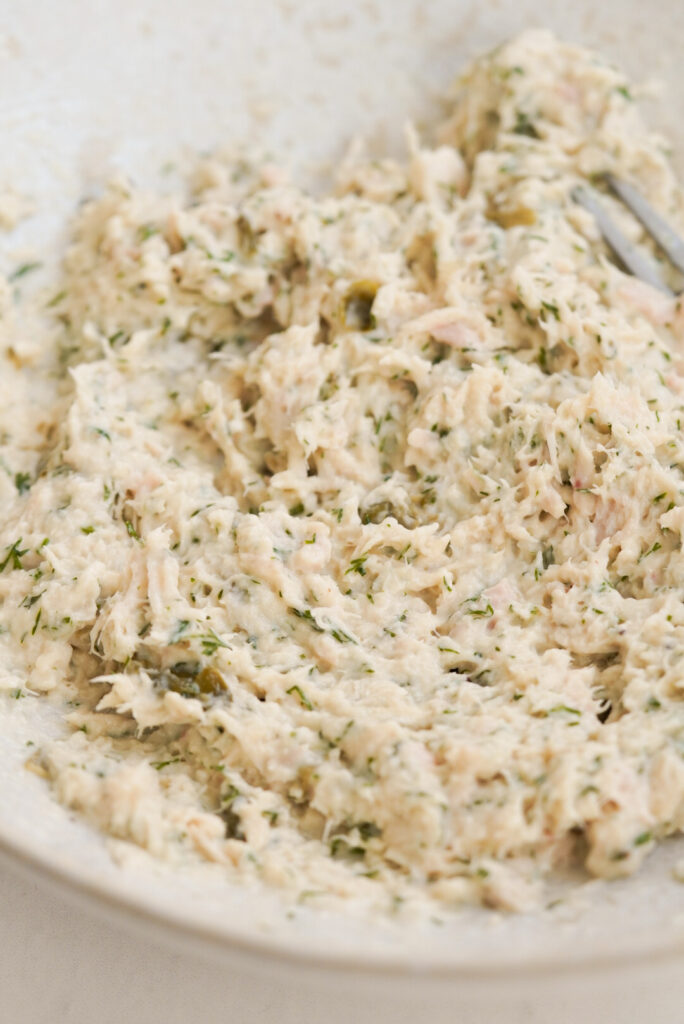
What is tuna salad?
Tuna salad is a cold salad consisting mainly of canned tuna and mayonnaise. It is a convenient, affordable dish that has been eaten for over 100 years in America and beyond.
The tuna is typically cooked, canned tunafish that is packed in either water or oil. I personally prefer albacore tuna, but you could also use yellowfin or skipjack tuna. Other common ingredients in tuna recipes include lemon juice, red or green onion, olive oil, fresh herbs, dijon mustard, or relish.
Why I Love Tuna Salad
I have always loved tuna salad! I grew up eating and loving it, and that love has only grown since I’ve become an adult. I absolutely love having a big batch of tuna salad made with simple ingredients on hand to enjoy throughout my week! It’s delicious, versatile, healthy, and convenient:
- Delicious: Tuna salad makes for such a delicious lunch, especially if you load it up with flavorful ingredients – fresh herbs, spices, crunchy veggies, condiments, and more. The best tuna salad recipe, in my humble opinion, is the one I use in my lettuce wraps. It’s full of celery, red onion, fresh parsley, and whole grain mustard. It is seriously incredible!
- Versatile: There are endless ways tuna salad can be enjoyed – lettuce wraps, crackers, tuna melts, pasta salad, tuna salad sandwiches, and more! Or just on its own by the spoonful. No matter what vessel you choose to enjoy tuna salad in, it always makes for a light and fresh lunch or a perfect protein-packed snack
- Healthy: The healthiness of your tuna salad will depend on the ingredients you choose to make it with, but at its core tuna salad is extremely healthy. Tuna is a protein powerhouse! The lean fish boasts about 30 grams of protein per serving at 100-150 calories. Just make sure to limit the mayo and bulk up your salad with nutritious veggies to keep things light.
- Convenient: I always have a couple of cans of tuna in my cupboard and mayo in my fridge, which means tuna salad is never far from my reach. It’s a reliable, convenient, and affordable protein source for when I’m having a busy day at work or I’m running low on groceries!
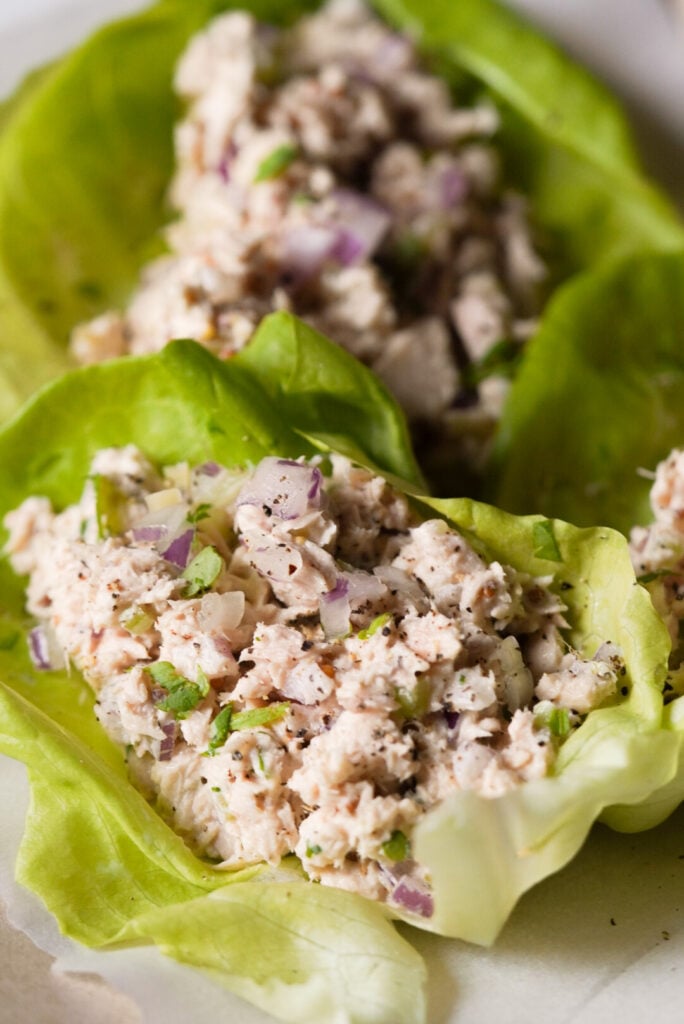
How To Properly Store Tuna Salad In The Fridge
The first step in properly storing tuna salad is to make sure it is refrigerated within 2 hours of preparing or purchasing. If tuna salad is left out at room temperature for longer, it should immediately be discarded.
This is necessary because room temperature falls within the danger zone for food safety, 40-135 degrees Fahrenheit. Bacterial growth increases rapidly within these temperatures. It could reach harmful levels and result in food-borne illness or food poisoning, if the food is consumed. This is why the Meat and Poultry Hotline says to “never leave food out of refrigeration over 2 hours.”
If the temperature exceeds 90 degrees F, this time period shortens further to 1 hour. Therefore, on a hot summer day tuna salad will need to be refrigerated within 1 hour of preparing or purchasing in order to prevent it from spoiling!
Storage Techniques
You will need to place leftover tuna salad in a well fitting, airtight container. Glass containers are preferable to plastic containers, but both will work better than a bowl with plastic wrap. This method will not keep tuna salad very well for very long.
Then to maintain tuna salad’s maximum freshness, place it in the coldest part of the refrigerator. This will be further towards the back, not close to the front near the door or on the door itself. Additionally, ensure the fridge is below 40 degrees F.
Another helpful tip for storing tuna salad, or anything for that matter, is to label your storage container with the date in which it was stored. Therefore, you will know when the safe-to-consume time period is up and you won’t eat spoiled food by accident.
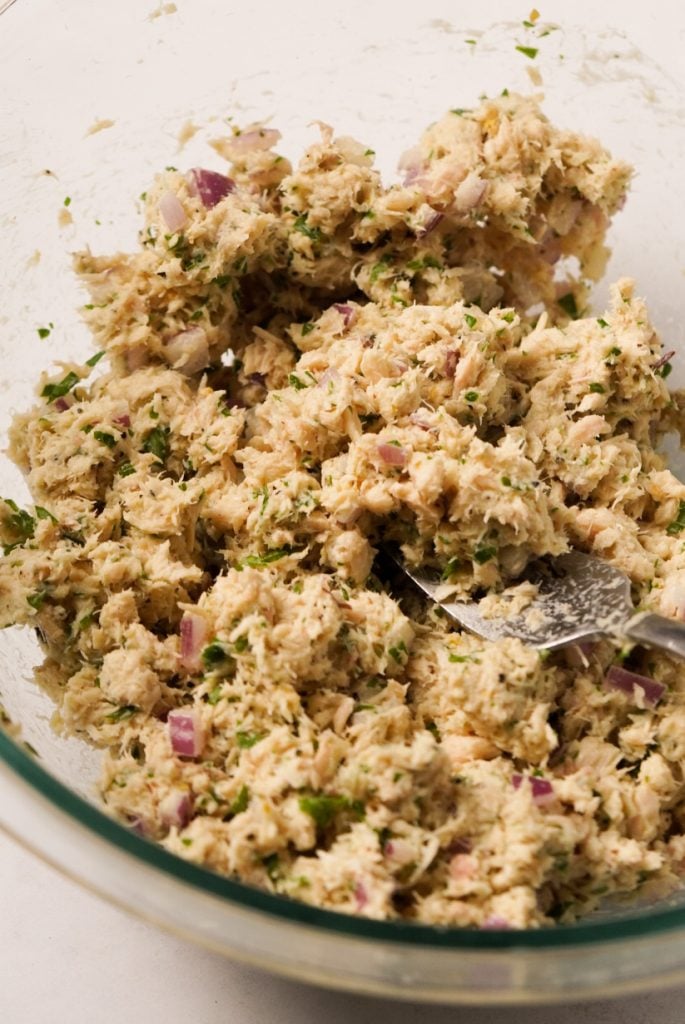
Can I freeze tuna salad?
Freezing tuna salad is not recommended. The mayo can separate when frozen and any other mix-ins, especially crunchy vegetables, can become soggy and limp once frozen then thawed. This includes ingredients like dill pickles or bell pepper.
However, it is all about personal preference. Technically it is perfectly safe to freeze tuna salad and it can absolutely be done. The overall quality and taste will just not be the same if frozen and thawed.
If you do choose to freeze it, tuna salad lasts 1-2 months in the freezer. Make sure you thaw it properly to maintain its quality and freshness as best as possible. Place in the fridge and gradually thaw before consuming.
How To Prolong The Shelf Life Of Tuna Salad
There are a few different way to prolong tuna salad shelf life! To make it last it’s full storage period of 3-4 days I recommend employing the tips below.
- Fresh Ingredients: It is vital that you use fresh ingredients when preparing tuna salad in order for it to stay good for an extended period of time. You will want to make sure any vegetables or herbs (any perishable foods) that you mix in are at their prime, not close to spoiling themselves!
- Durable Ingredients: To keep your tuna salad edible for 3-4 days, only use ingredients that will last that long themselves. For example, avocado will not keep well and make your tuna salad’s shelf life shorter. The green vegetable oxidizes very quickly and could cause your salad to turn brown or spoil.
- Prevent Contamination: As with any food, to maximize tuna salad’s freshness it is important to prevent cross contamination when preparing it. Keep your prep area clean, use separate utensils, and thoroughly wash your hands and work surface to prevent the spread of bacteria or other spoilers.
- Natural Preservation: Try adding lemon juice to your tuna salad! The acidity in lemon juice makes it a natural preserver. It will also add great taste. You could try adding other acidic ingredients to your salad too … such as pickle relish.
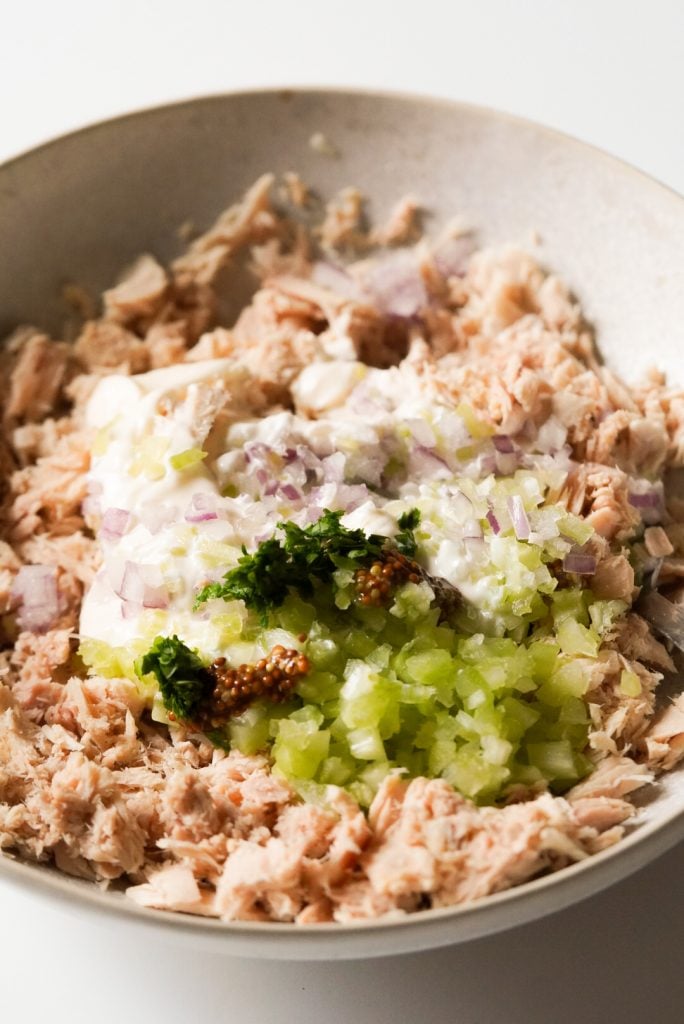
How To Know If Tuna Salad Has Gone Bad
There are multiple ways to tell if tuna salad has gone bad! The signs of spoilage will be fairly obvious to your various senses – sight, smell, and touch. Taste, too! Although, using that sense is not recommended when checking a food item for spoilage.
Only try a small taste of tuna salad if the below signs of spoilage are not present and it has been stored for less than 3-4 days. If there is a sour or unusual taste, your salad has gone bad and you will need to toss it. If the below signs of spoilage are present, do not taste. This could lead to potential health risks!
Signs of Spoilage
- Appearance: Spoiled tuna salad could have mold or dark spots. Removing the spots will not work here, like with cheese. Toss immediately!
- Smell: Tuna salad past its expiration date could have a bad odor or pungent smell due to mold or bacteria growth. If noticed, you will need discard the salad immediately. However, since tuna salad tends to have a strong smell already, scent is not the most reliable sense to use in this instance!
- Feel: Feel is another slightly difficult one here because of the natural consistency of the salad. But if your tuna has an unusually slimy feel it is most likely spoiled and should not be eaten.
How to know if tuna salad has gone bad? Answer: The short answer is by using visual cues, smell, and timing. Timing is an important one. Even if signs of spoilage (unpleasant odor, mold, dark spots, etc.) are not present in your tuna salad, but it has been stored for longer than 3-4 days … it has gone bad. It is no longer safe to eat and you will need to toss it! Another immediate way to know if your tuna salad has gone bad, is if it is left out at room temperature (a danger zone for food safety) for longer than 2 hours.
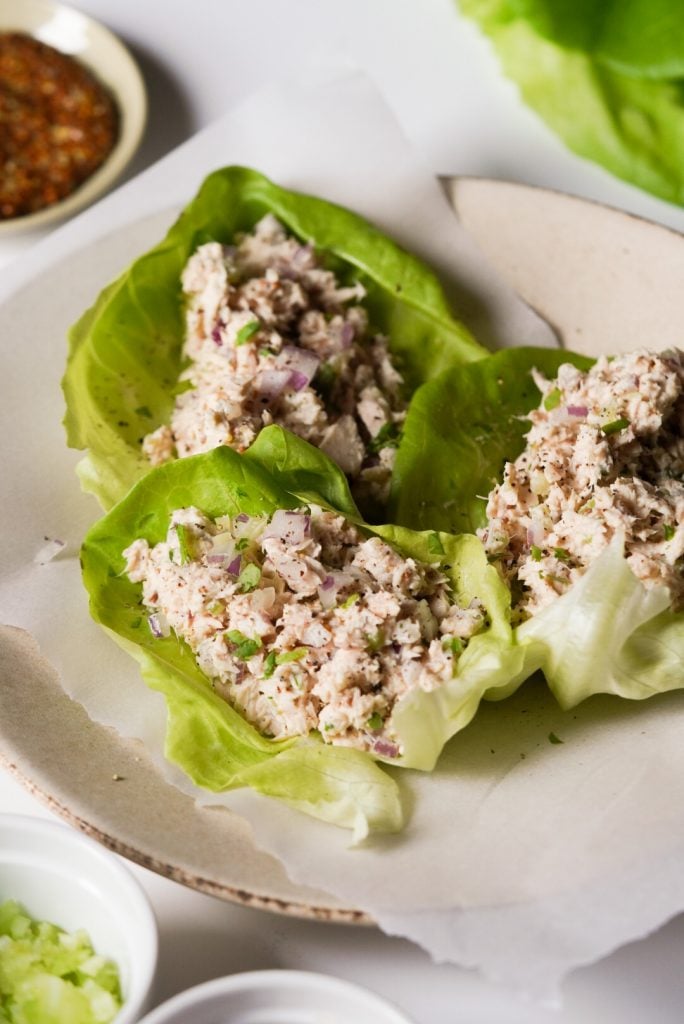
Tuna Salad Recipes
If you are a tuna salad lover like I am, as I’m sure you are since you are here, you have to check out some of my favorite recipes for the lunchtime staple!
- Tuna Salad Lettuce Wraps: Made with butter lettuce, albacore tuna, mayonnaise, whole grain mustard, red onion, and celery … this simple recipe is crunchy, nutritious, and delicious. This no-cook meal is a wonderful low carb, high protein recipe.
- Spicy Mayo Tuna Rice Bowl: This easy recipe made with canned tuna, Jasmine rice, spicy mayo, and the fresh toppings of your choice is such a fabulous lunch option. It is like a deconstructed sushi bowl – full of all the delicious umami flavor, without any of the hassle!
- Lemmon Pepper Tuna Salad: Made with white tuna, lemon pepper seasoning, mayo, lemon juice, red onion, and fresh parsley … this tuna salad salad is light, bright, fresh, and flavorful. Great for meal prep!
- Joe & The Juice Copycat Tunacado: Made with crispy flatbread, creamy tuna mousse, basil pesto, fresh avocado, and juicy tomato … this viral sandwich has an incredible mix of textures and delicious flavor.

Tuna Salad Storage FAQs
Tuna salad lasts 3-4 days when properly stored in the fridge.
No, tuna salad should not be frozen. While it is possible, it is not recommended. Tuna salad simply does not freeze well and will not be enjoyable once frozen and thawed.
Yes! Both homemade and store bought tuna salad can be stored in the same way. In an airtight container, preferably glass container, in the refrigerator.
However, it is important to note the day that the store bought tuna salad was prepared. It may last in your fridge shorter than the guideline of 3-4 days if prepared a day or two prior to when you purchased it. I recommend buying tuna salad prepared as freshly as possible!
It is not recommended to eat tuna salad after 5 days. USDA guidelines state that cooked fish is only good for 3-4 days when refrigerated. Additionally, foodsafety.gov states that the refrigerated shelf life of cold salads (tuna, egg, chicken, etc,) is 3-4 days.
It is not recommended to eat tuna salad after a week. USDA guidelines state that cooked fish is only good for 3-4 days when refrigerated. Additionally, foodsafety.gov states that the refrigerated shelf life of cold salads (tuna, egg, chicken, etc,) is 3-4 days.
To make tuna salad last longer I recommend you use the freshest ingredients possible when preparing it and proper techniques when storing it.
How to properly store tuna salad and tips for prolonging it’s shelf life are discussed in great detail above.
Nope! Tuna salad can be prepared in advanced and stored in the refrigerator for 3-4 days.
References
- https://www.fsis.usda.gov/food-safety/safe-food-handling-and-preparation/food-safety-basics/leftovers-and-food-safety
- https://www.foodsafety.gov/food-safety-charts/cold-food-storage-charts
- https://en.wikipedia.org/wiki/Tuna_salad
- https://www.fsis.usda.gov/food-safety/safe-food-handling-and-preparation/food-safety-basics/how-temperatures-affect-food

I regularly eat tuna salad a week old or older and have so for years and years!